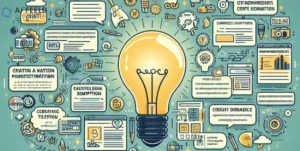Artificial Intelligence (AI) has fundamentally altered the landscape of User Experience (UX) design, propelling it into an era of unprecedented innovation and user centricity. AI’s integration in UX has not only elevated the quality of digital interactions but has also redefined the way designers approach creating digital experiences.
Using AI for UX design is like having a smart helper. It’s about teaching computers to understand what people like and making things easy to use. Want to know more about how to use AI for UX design? It’s all about making stuff online even better for you.
Using AI for UX design means teaching computers to create websites and apps that people find easy and fun to use. It helps personalize your experience online and makes things more convenient for you. AI in UX design aims to make technology feel like it understands and helps you better.
How does artificial intelligence impact UX design
Artificial Intelligence (AI) significantly impacts User Experience (UX) design by revolutionizing how designers understand user behavior. Through AI powered analytics, designers can gather intricate insights into user preferences, interactions, and patterns. This data enables the creation of more personalized and intuitive interfaces, enhancing the overall user experience.
Also, AI automates certain design processes, streamlining tasks such as user testing and prototyping, including test AI and ML applications. The automation allows designers to concentrate on creativity, shaping user-centric designs that are visually appealing and highly functional for users.
Challenges of using AI for product development
Using AI for product development brings numerous advantages, yet it also presents several challenges. One significant hurdle is the quality and quantity of data required for effective AI utilization. AI systems heavily rely on extensive, high quality datasets to learn and make accurate predictions. In product development, obtaining and curating such datasets can be time consuming and costly, particularly when dealing with proprietary or scarce data.
Another challenge is the interpretability of AI driven decisions. Understanding the rationale behind AI generated insights or design suggestions can be intricate. The absence of transparency may hinder trust in AI recommendations, challenging developers to understand its reasoning for adoption. Balancing these challenges is crucial for successful integration of AI in product development.
5 ways to use AI to improve the user experience
Here are five ways to use AI to enhance user experience:
- AI powered personalization tailors content to individual preferences, making experiences more relevant.
- Chatbots equipped with AI provide instant support and guidance to users, improving their interaction with a service or platform.
- Predictive analysis using AI helps anticipate user needs, offering proactive solutions and suggestions.
- AI driven recommendation systems suggest products or content based on user behavior, enhancing their experience.
- Automated processes through AI streamline user journeys, making interactions smoother and more efficient.
Applications of AI in UX Design
AI is used in UX design to improve user experiences by personalizing content and predicting user preferences.
Natural Language Processing (NLP) in UX
NLP allows machines to understand, interpret, and respond to human language. In UX design, this technology helps in creating conversational interfaces, chatbots, and voice controlled applications, enhancing user interaction and accessibility.
Image and Visual Recognition in UX
AI powered image recognition optimizes user experiences by analyzing visual content. It facilitates content customization and improves engagement by presenting users with visually appealing and relevant information.
Predictive Analytics and User Behavior
Predictive analytics, driven by AI, enables the anticipation of user behavior. By analyzing past user interactions, designers can personalize recommendations and interfaces, meeting the evolving needs and expectations of users.
Practical Implementation of AI for Design
Utilizing AI in design is revolutionizing various industries, offering innovative solutions and streamlining processes. From architecture to graphic design, AI algorithms aid in generating intricate designs, enhancing creativity, and expediting tasks. In architecture, AI analyzes complex data to create strong designs; in graphic design, it automates image editing and layout tasks.
Implementing AI in design entails the utilization of different tools and techniques. Designers incorporate AI driven software to produce detailed models, predict design outcomes, and optimize user experiences. This integration results in improved efficiency, cost effectiveness, and the ability to handle intricate design requirements.
| Design Field | AI Application |
| Architecture | Generative Design, Structural Analysis |
| Graphic Design | Image Editing, Layout Generation |
| Product Design | Prototyping, Design Optimization |
| Fashion Design | Trend Forecasting, Pattern Generation |
| Interior Design | Space Planning, Material Selection |
Improving User Experience with AI

AI technology significantly enhances user experience by personalizing interactions and anticipating user needs. Through AI driven algorithms, platforms can analyze user behavior, preferences, and historical data to tailor suggestions and content, ultimately providing a more tailored and streamlined experience. For instance, AI powered chatbots offer immediate and accurate responses, resolving user queries swiftly, thereby improving overall satisfaction and engagement.
AI enables intuitive and user centric interfaces by adapting to individual habits and preferences. With machine learning, applications can adjust their interfaces, making them more user friendly and easier to navigate. This approach not only simplifies the user experience but also fosters a sense of connection and understanding, ensuring that technology aligns more closely with the user’s requirements and expectations, ultimately leading to improved usability and satisfaction.
Customization and Adaptability
AI enables the creation of personalized experiences, adapting to individual user needs and preferences, thereby fostering stronger user engagement.
Predictive Analysis for UX Optimization
Through predictive analysis, AI anticipates user needs, allowing for proactive UX design modifications that optimize the overall experience.
AI driven Interface Design
By leveraging AI in interface design, designers can create interfaces that are not only aesthetically appealing but also highly functional and user centric.
Using AI in your product development process
Integrating AI in your product development process can streamline tasks, making them more efficient and precise. By utilizing AI algorithms, you can analyze extensive data sets to gain insights, foresee market trends, and enhance decision making. This technology enables predictive modeling, allowing you to anticipate user preferences and tailor your product accordingly, resulting in better user experiences.
AI contributes significantly to automating repetitive tasks, reducing human error, and accelerating the overall development cycle. It assists in identifying potential issues early in the process, saving time and resources. Integrating AI into product development drives innovation, competitiveness, and user centricity, meeting today’s dynamic market demands effectively.
Create effective UX with Chameleon’s AI feature
Chameleon’s AI feature empowers users to craft seamless and intuitive user experiences effortlessly. By leveraging this innovative tool, designing interfaces becomes more intuitive and efficient, allowing for personalized interactions based on individual user behaviors and preferences. The AI powered feature in Chameleon empowers designers to craft adaptive, evolving user experiences, creating highly engaging interfaces.
Also, Chameleon’s AI feature streamlines the UX design process by analyzing user interactions and providing insights for optimizing layouts and functionalities. This intelligent technology interprets user data, allowing for the implementation of dynamic interfaces that continuously learn and enhance the user journey. Ultimately, it aids designers in creating visually appealing, highly functional interfaces, ensuring engaging user experiences for satisfaction.
FAQs
What role does AI play in improving UX design?
AI optimizes UX by personalizing experiences, streamlining user research, and enhancing design processes.
Are there specific AI tools for UX designers?
Yes, various AI powered tools aid designers in prototyping, user testing, and design automation.
How does AI enhance user interaction in design?
AI improves user interaction by offering customization, predictive analysis, and refining interface designs for a better user experience.
Conclusion
Using AI for UX design can greatly improve how we make things for people. It helps in understanding what users need, making products better for them. By using AI, we can create designs that fit users’ wants and needs more accurately. It also speeds up the design process by automating some tasks, saving time and effort.
Overall, AI brings a smart way to make products that are user friendly and more effective. It’s like having a helper that knows what users like and guides us to make things they’ll love. Embracing AI in UX design means creating products that truly connect with people, making their experiences smoother and more satisfying.











